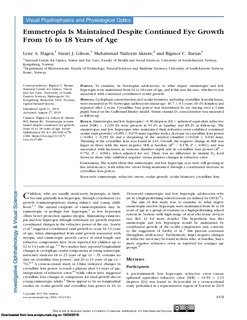| dc.contributor.author | Hagen, Lene Aarvelta | |
| dc.contributor.author | Gilson, Stuart | |
| dc.contributor.author | Akram, Muhammad Nadeem | |
| dc.contributor.author | Baraas, Rigmor C. | |
| dc.date.accessioned | 2019-10-25T08:07:29Z | |
| dc.date.available | 2019-10-25T08:07:29Z | |
| dc.date.created | 2019-10-23T11:02:22Z | |
| dc.date.issued | 2019 | |
| dc.identifier.citation | Investigative Ophthalmology and Visual Science. 2019, 60 (13), 4178-4186. | nb_NO |
| dc.identifier.issn | 0146-0404 | |
| dc.identifier.uri | http://hdl.handle.net/11250/2624357 | |
| dc.description | This work is licensed under a Creative Commons Attribution 4.0 International License. | nb_NO |
| dc.description.abstract | PURPOSE. To examine, in Norwegian adolescents, to what degree emmetropia and low hyperopia were maintained from 16 to 18 years of age, and if this was the case, whether it was associated with continued coordinated ocular growth. METHODS. Cycloplegic autorefraction and ocular biometry, including crystalline lens thickness, were measured in 93 Norwegian adolescents (mean age: 16.7 6 0.3 years; 63.4% females) and repeated after 2 years. Crystalline lens power was determined by ray tracing over a 1-mm pupil, based on the Gullstrand-Emsley model. Serum vitamin D3 concentration was measured at follow-up. RESULTS. Emmetropia and low hyperopia (0.50 diopters [D] < spherical equivalent refractive error [SER] < þ2.00 D) were present in 91.4% at baseline and 89.2% at follow-up. The emmetropes and low hyperopes who maintained their refractive error exhibited continued ocular axial growth (þ0.059 6 0.070 mm) together with a decrease in crystalline lens power (0.064 6 0.291 D) and a deepening of the anterior chamber (þ0.028 6 0.040 mm). Thinning of the crystalline lens was found in 24%. Overall, the negative change in SER was larger in those with the most negative SER at baseline (R2 ¼ 0.178, P < 0.001), and was associated with increases in vitreous chamber depth and in crystalline lens power (R2 ¼ 0.752, P < 0.001), when adjusted for sex. There was no difference in vitamin D3 level between those who exhibited negative versus positive changes in refractive error. CONCLUSIONS. The results show that emmetropic and low hyperopic eyes were still growing in late adolescence, with refractive errors being maintained through a coordinated decrease in crystalline lens power. | nb_NO |
| dc.language.iso | eng | nb_NO |
| dc.rights | Navngivelse 4.0 Internasjonal | * |
| dc.rights.uri | http://creativecommons.org/licenses/by/4.0/deed.no | * |
| dc.title | Emmetropia Is Maintained Despite Continued Eye Growth From 16 to 18 Years of Age | nb_NO |
| dc.type | Journal article | nb_NO |
| dc.type | Peer reviewed | nb_NO |
| dc.description.version | publishedVersion | nb_NO |
| dc.rights.holder | Copyright 2019 The Authors | nb_NO |
| dc.source.pagenumber | 4178-4186 | nb_NO |
| dc.source.volume | 60 | nb_NO |
| dc.source.journal | Investigative Ophthalmology and Visual Science | nb_NO |
| dc.source.issue | 13 | nb_NO |
| dc.identifier.doi | 10.1167/iovs.19-27289 | |
| dc.identifier.cristin | 1739781 | |
| cristin.unitcode | 222,56,2,0 | |
| cristin.unitcode | 222,58,4,0 | |
| cristin.unitname | Institutt for optometri, radiografi og lysdesign | |
| cristin.unitname | Institutt for mikrosystemer | |
| cristin.ispublished | true | |
| cristin.fulltext | original | |
| cristin.qualitycode | 2 | |

